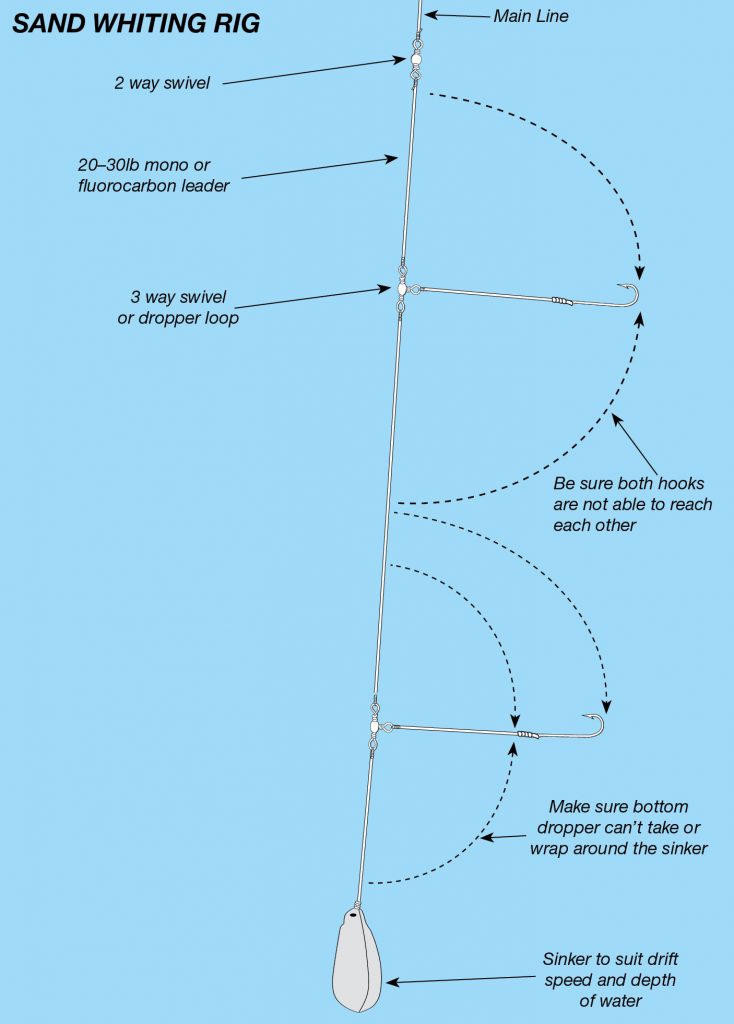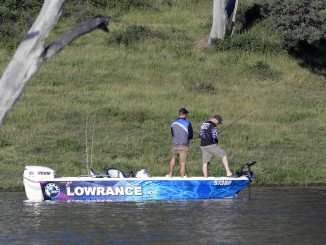
by Ian Sewell •
Sand whiting would have to be one of the easiest fish to target in the West Coast zone – they are very easy to catch and are exceptional eating. While they might be small they more than make up for their size in flavour. The best part about sandies is the fact that you can catch them from any sized boat or from shore. Beaches tend to fish better at night than during the day, but in saying that if you get onto them the day fishing can also be well worthwhile and if you do not pick up sandies you have a good chance at some yellowfin whiting instead.
Sand whiting can grow up to 40cm, however they are far more common in the smaller size range of about 20-30cm. There is no legal size for sand whiting and the bag limit is 30 fish per angler. Even though there is no size limit, setting a personal size limit is not a bad idea. Trying to fillet a heap of small fish can become old very fast. Personally, my whiting only hit the ice if they are 26cm and above. This size is big enough to give a decent fillet and relatively easy to work on, any smaller and they are just too fiddly.
Catching whiting is very easy, however catching bigger whiting takes a bit more effort. There is no end to the sand off our coast and just about all of this sand will hold whiting. Whiting can be caught from 5m of water out to 40m and deeper. For ease, 10-20m is probably a good compromise. If you like to anchor and fish, your best bet is to find a suitable spot and do a drift or two to make sure the fish are there and that they are of a size that you want to catch. If the fish are generally small then it is best to move around until you catch a few bigger specimen and then anchor on that spot. Once anchored, a berley bucket near the bottom will attract the fish closer to your area. If drifting is your preference, also just keep moving until you find the better-sized fish, mark a waypoint on your plotter and then keep going over that area.
Whiting are not a very fussy or finicky fish, so tying rigs with a heavier leader than is needed is no issue. For shallow or beach fishing lighter leaders should be considered but anything 10m and over, 20lb leader is a great place to start and best of all the heavier leader will reduce the chances of tangles on the drop or retrieve. As far as the rig goes, a paternoster with 2 or 3 hooks is pretty hard to beat, the bottom hook will catch the majority of fish, but if you are on a good patch it is not uncommon to get double and triple headers.
Everyone has a favourite hook to use for whiting and there are some great options out there that work exceptionally well, in trying to find the best hook to suit your needs it is a good idea to consider a few things first. Whiting are very greedy, they will suck down a bait and a small hook with vigour and very often will get gut hooked, which makes them difficult to unhook and release if too small.
Your fishing technique is also worth considering when looking at hooks. If you are an active angler and you like to hang onto the rod and set the hook then you will probably want to consider a different hook to the rod holder angler. Young kids without much fishing experience will also fall into the rod holder angler category as they will also want a hook that the fish can hook itself on and that preferably hooks the fish in the lip rather than in the gut, so that they can be easily removed and released if too small. The last consideration for hooks is what bait you intend to use.
So, a basic rundown of hooks would look something like this.
For the rod holder angler and kids the Black Magic KL hook is a great option, these are a cross between a wide gap hook and a circle hook, so most fish will hook themselves and will also be hooked in the corner of the mouth or in the lip.
For the active angler who like to set the hook, wide gap or long shank hooks are the best choice. Chemically sharpened is also a wise decision, but if you are using smaller baits then the long shank is probably the best option. For many the red long shank hook is hard to go past, especially if you are a fan of using a bit of red tube above your hook, but more on that later.
When selecting hooks the most common mistake is to buy or use hooks that are very small and it is an obvious choice when you look at the size of a whiting mouth, they have a pretty small mouth. You would be amazed at what a small whiting can cram into its mouth though. The biggest issue with small hooks is that you will spend most of your day throwing back little fish. This is about getting a feed of big whiting, not a bucket of little ones. By using bigger hooks you will certainly get a lot of bites that you will not hook up on, which will usually be the smaller fish, but this activity around the bait will bring in the bigger specimens and will result in the fish that you finally hook and wind up being larger than the rest.
So how big, I hear you ask? Well for me it is 1/0 in the wide gap hook every time. When you look at this hook you will definitely say that I am crazy, but I can assure you even though I only keep whiting 26cm and over I still have to throw back plenty. The other benefit of using larger hooks is that when you get any by-catch like gummy shark, pink snapper (in season) or King George whiting you can be reasonably confident that it will be well enough hooked and that the hook will be strong enough to do the job.
The rod and reel you use for whiting fishing should be more matched around the sinker you have to fish rather than the size of the fish you are catching. As we are into late spring and summer fishing we can be pretty confident that the wind will either be blowing from the east or from the south to southwest. Either way chances are you will also have a fair drift going even if you catch the lull between the easterly and the sea breeze. Sinker weight will also have to increase the deeper you go. These fish are in the bottom metre or less of water, so if you stop getting bites then chances are you are not on the bottom and need more lead or have lost your bait.
To cope with the sinker required, an outfit suited to around 15-25lb is not out of the question. Where possible use a nice graphite rod with a quality braided line and you will feel every bite, no matter how small.
The only thing left is what bait to use? On this topic everyone has their own favourite. The bottom line is that whiting will eat pretty much anything. The best baits however will sustain a merciless and relentless attack from the whiting and stay on the hook, they might be small but they certainly aren’t timid when it comes to attacking a bait. So if you use soft baits like pieces of prawn they will be stripped off your hook in no time and you will find yourself rebaiting hooks instead of catching fish.
Some good baits include bloodworm or sandworms (as long as they are not soft), squid tentacles, ox heart, cut to size octopus tentacles, small strips of red meat or small strips of fish fillet (skin on) being sure to put the hook point through the skin. Of most importance is to not overfill the hook with bait, cutting baits into thin wedge shaped strips gives a great presentation and cuts down on line twist on the way up and down. With the strip just put the hook through the fatter end twice and that should be enough, any more and the hook gap will begin getting full and will reduce its hook up rate. Worth noting are some of the biodegradable soft plastics now available like the Gulp worms, these work pretty well as bait and are very easy to store so are a great option for travelling anglers or just to keep as a back up in the tackle box.
Worth mentioning is the whiting rig bling. Many seasoned whiting fishers love a bit of bling, probably the most popular is a thin bit of red plastic tubing that sits on the leader above the hook. For others the green glow in the dark tube is the preference while others like red beads. If you decide for a bit of bling then it certainly will not hurt, and sometimes it might even produce more fish. I guess it is up to each individual angler to make up their own mind on what colour or type suits them or if they want to use it at all. Just about every store bought whiting rig has the bling already attached so I guess there is a reason for it.
As I mentioned right at the beginning, whiting are sensational eating, they have a very delicate flesh and no matter how they are cooked will delight the diner. To keep whiting in the best condition be sure to drop the keepers directly into an ice slurry with plenty of ice. Being small if they get warm the flesh will start to deteriorate almost immediately and the flesh will start to get a bit soft and mushy and will make filleting harder. Remember to remove the pin bones and enjoy one of the finest eating fish in the ocean.
Oh, and one last thing, it is not a bad idea if you have the room to run a squid jig or two while whiting fishing or at least have one rigged up and on hand. It is pretty rare that you do not have a whiting followed up by a squid at some stage during a good whiting session.











